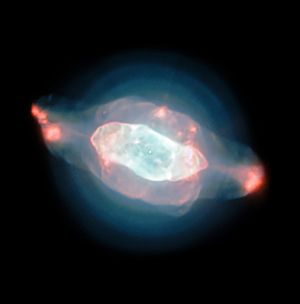Saturn Nebula facts for kids
| Emission nebula | |
|---|---|
| Planetary nebula | |

NGC 7009 by Very Large Telescope.
|
|
| Observation data: J2000.0 epoch | |
| Right ascension | 21h 04m 10.877s |
| Declination | -11° 21′ 48.25″ |
| Distance | 2000-4000 ly (See article) ly |
| Apparent magnitude (V) | 8.0 |
| Apparent dimensions (V) | 41″ × 35″ |
| Constellation | Aquarius |
| Physical characteristics | |
| Radius | 0.2 to 0.4 ly |
| Absolute magnitude (V) | 2.5 to 1 |
| Notable features | - |
| Designations | NGC 7009, Caldwell 55 |
The Saturn Nebula is a beautiful cloud of gas and dust in space. It is called a planetary nebula, but it has nothing to do with planets! This name was given a long time ago because some of these objects looked like planets through early telescopes. The Saturn Nebula is found in the constellation of Aquarius, which is a group of stars that form a pattern in the night sky. It is very far away from Earth, about 2,400 light-years from us. A light-year is the distance light travels in one year, which is a very, very long way!
Contents
What is the Saturn Nebula?
The Saturn Nebula is a type of emission nebula. This means it glows because the gas inside it is heated by a very hot, dying star at its center. It was formed when a star, similar to our Sun but much older, ran out of fuel. When this happens, the star expands into a red giant and then sheds its outer layers of gas into space. This creates the colorful, glowing cloud we see.
Why is it called the Saturn Nebula?
The Saturn Nebula gets its name because of its unique shape. When viewed through a telescope, it looks a bit like the planet Saturn with its rings. This is because it has a bright, oval-shaped center and two faint "handles" or "ansae" sticking out from the sides, which resemble Saturn's rings. These "handles" are actually jets of gas shooting out from the central star.
Where is the Saturn Nebula located?
This amazing nebula is located in the southern part of the constellation Aquarius. You can't see it with your eyes alone, but with a good telescope, it's a wonderful sight. Its official name is NGC 7009, which stands for New General Catalogue, a list of thousands of nebulae, galaxies, and star clusters. It's also known as Caldwell 55.
How big and bright is it?
The Saturn Nebula is quite large, stretching about 0.2 to 0.4 light-years across. Even though it's huge, it appears small from Earth because it's so far away. It has an apparent magnitude of 8.0, which means it's not very bright to our eyes. The lower the number, the brighter an object appears. For comparison, the brightest stars are magnitude 0 or 1.
The central star
At the very heart of the Saturn Nebula is a tiny, incredibly hot white dwarf star. This star is what's left of the original star that created the nebula. It's super hot, with a surface temperature of about 65,000 degrees Celsius (117,000 degrees Fahrenheit)! This intense heat makes the surrounding gas glow brightly.
Images for kids
-
NGC 7009 by Hubble Space Telescope.
-
1848 drawing of NGC 7009 by Lord Rosse.
See also
 In Spanish: Nebulosa Saturno para niños
In Spanish: Nebulosa Saturno para niños



